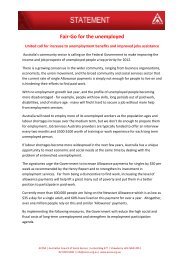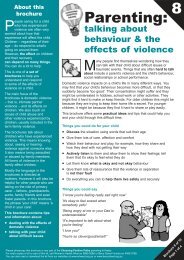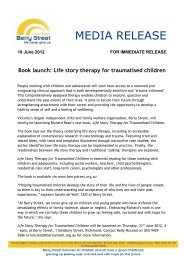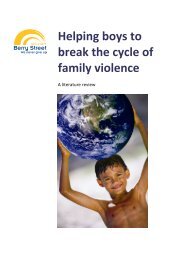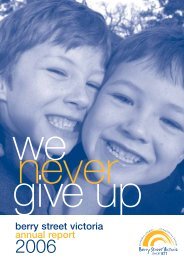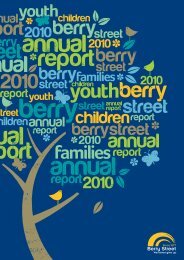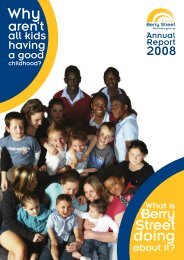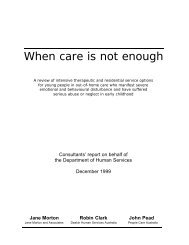Therapeutic foster care - Berry Street Childhood Institute
Therapeutic foster care - Berry Street Childhood Institute
Therapeutic foster care - Berry Street Childhood Institute
Create successful ePaper yourself
Turn your PDF publications into a flip-book with our unique Google optimized e-Paper software.
• Small or low child welfare case worker<br />
caseloads, to enable them to work more<br />
intensively with each child and family.<br />
• Higher stipend (reimbursement) than traditional<br />
<strong>foster</strong> <strong>care</strong>rs.<br />
• Professional treatment parents or <strong>care</strong>givers who<br />
participate as members of a treatment team.<br />
• Comprehensive assessment of the child and<br />
matching process.<br />
• Support services for <strong>care</strong>rs, including regular<br />
supervision and access to clinical consultation.<br />
• Provision of clinical treatment for children,<br />
<strong>care</strong>rs and biological families.<br />
• Crisis intervention services.<br />
• Educational services (some).<br />
• Health screening and medical services as per<br />
assessment<br />
• Co-ordination of services ensuring system<br />
linkages (<strong>care</strong> team approach).<br />
Difference between TFC and general<br />
<strong>foster</strong> <strong>care</strong><br />
A key difference between TFC and general <strong>foster</strong> <strong>care</strong><br />
is the role of the <strong>care</strong>r. Essentially, <strong>care</strong>rs in TFC are<br />
regarded as part of a professional treatment team.<br />
Some TFC organisations have attempted to define<br />
this difference stating that, “While all treatment parents<br />
are <strong>foster</strong> parents, not all <strong>foster</strong> parents are treatment<br />
parents. Treatment parents serve both as <strong>care</strong>givers of<br />
children with treatment needs (the <strong>foster</strong>ing role) and as<br />
active agents of planned change (the treatment role)”<br />
(FFTA, program standards, 2004, p. 19).<br />
Others have emphasised the child and their family's<br />
access to intensive treatment as fundamental to TFC<br />
programs. “Treatment <strong>foster</strong> family programs are<br />
distinguished from traditional <strong>foster</strong> home placements by<br />
their emphasis on planned intensive treatment of<br />
children, which it is hoped, will develop effective<br />
interpersonal, emotional, and social behaviours”<br />
(Thomlison, 1991, p. 2).<br />
It has also been argued that children in TFC are more<br />
traumatised and challenging in their behaviour than<br />
those in general <strong>foster</strong> <strong>care</strong>. This is reflected in the<br />
increased <strong>care</strong>giver reimbursements, intensity of<br />
staffing and intensive treatment provided. Thomlison<br />
(1991, p. 3) writes, “Treatment <strong>foster</strong> <strong>care</strong> children are<br />
substantially more difficult to understand and to parent.<br />
This is due to the extensive and negative child and family<br />
interactions over longer periods of time than for a child<br />
placed in traditional <strong>foster</strong> <strong>care</strong>.” A more comprehensive<br />
and detailed description of the elements of TFC is<br />
provided below and serves to distinguish further<br />
how TFC differs from traditional <strong>foster</strong> <strong>care</strong> models.<br />
Characteristics of TFC<br />
Enhanced services and <strong>care</strong>giver<br />
reimbursements in TFC<br />
Typical of most therapeutic <strong>foster</strong> <strong>care</strong> programs are the<br />
higher rates of reimbursements provided to <strong>care</strong>givers.<br />
An interesting study conducted by Chamberlain and<br />
colleagues (1992) explored the impact of providing<br />
<strong>care</strong>rs with enhanced training and support services<br />
plus a small increase in their <strong>care</strong>giver reimbursement<br />
rate on <strong>care</strong>giver retention rate. A sample of 72 children<br />
and their <strong>care</strong>rs were included in the study and placed<br />
into one of three groups. One group was given an<br />
increased <strong>care</strong>giver payment and offered weekly group<br />
sessions as well as telephone contact with program staff<br />
members three times per week (referred to as the<br />
enhanced placement group). A second group was<br />
provided with an increase in their <strong>care</strong>giver payment<br />
without additional support. The control group was<br />
provided with neither an enhanced training and<br />
support, nor an increase in <strong>care</strong>giver reimbursement.<br />
The results of the study indicated that <strong>care</strong>giver<br />
retention rate was impacted by the level of support<br />
and increased reimbursements, with significantly less<br />
<strong>care</strong>rs discontinuing (16.6%) compared to a statewide<br />
drop out rate of 40%. Outcomes for children in<br />
the enhanced placement group were reported as<br />
significantly more successful (based on daily report<br />
measures) than children in each of the other two<br />
groups. This study suggests that <strong>care</strong>r retention is<br />
influenced by increasing <strong>care</strong>giver reimbursements<br />
and enhancing training and support to <strong>care</strong>rs<br />
(Chamberlain et al., 1992). Such findings provide a<br />
strong argument of the potential benefits to children<br />
and their <strong>care</strong>rs when additional supports and<br />
resources are provided. These enhanced placement<br />
services are also consistent with a professionalisation<br />
of <strong>foster</strong> <strong>care</strong> and therapeutic <strong>foster</strong> <strong>care</strong> models.<br />
Characteristics of children in TFC<br />
Whilst there is a large volume of literature that notes<br />
children in out of home <strong>care</strong> have complex needs,<br />
there appears to be a limited number of studies which<br />
have attempted to distinguish the different<br />
characteristics of children in TFC from traditional<br />
<strong>foster</strong> <strong>care</strong>. One description of the characteristics of<br />
children and youth served by TFC includes those<br />
children with “serious emotional and behaviour problems<br />
who have experienced significant abuse or neglect and<br />
multiple out-of-home placements, including hospital or<br />
residential settings” (Bryant, 2004).<br />
A more detailed account of the characteristics of<br />
children and youth served by TFC has been<br />
investigated by Hudson and colleagues (1994) in a<br />
study of 321 TFC programs. Several key<br />
characteristics of children and youth in TFC included;<br />
• The ages of children in TFC were: 8% less than<br />
6 years old, 25% were 6-11 years old, 28% were<br />
12 to 14 years old and 38% were 15-17 years old.<br />
<strong>Therapeutic</strong> Foster Care 11



